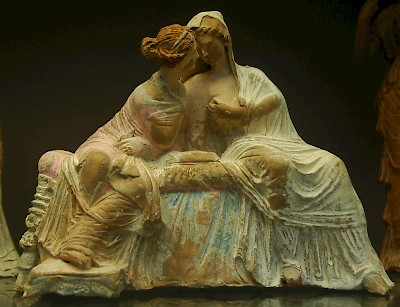Herodas
Herodas (Greek: Ἡρώδας): Hellenistic poet, author of several mimes, short poems containing a farce.
The Author

Among the Hellenistic poets, about whom we know so very little, Herodas is one of the most shadowy ones. Even his name is not certain: it is usually spelled as Herodas, but also as Herondas and Heroidas. His birthplace is unknown and so is his place of residence. His dialect and a couple of references in his poems suggest that he knew the isle of Kos, but Alexandria is a possibility too. From a letter by the Roman senator Pliny the Younger, written in c. 100 CE, we know that Herodas was a contemporary of Callimachus and the author of a book of iambic poetry.note This would place Herodas in the first half of the third century BCE. Unfortunately, this is all we can know.
Work
In ancient times, Herodas was rarely mentioned or quoted. As a consequence, most of his poems were lost, except for twenty lines. In 1891, however, a papyrus containing no less than 700 verses was discovered in the tomb of one Serapis, son of a Serapion; these men lived at the beginning of the common era. All in all, we now have eight more or less complete mimes, as his poems are called, and fragments of three others.
Mimes
Although Herodas’ type of poetry is often labeled mime, it should actually be called the mimiambe, a combination of the mime and the iambus.
The word mimus means “imitation” and was the name of a short farce with (often improvised) scenes from daily life. Originally, this was not a recognized literary form, and it is not mentioned by historians and philosophers before the fourth century BCE.
The iambus was a poem in iambic verses (˘ ¯,˘ ¯, ˘ ¯, etc.) that was in vogue in the Aegean Islands from the seventh century BCE. Iambic poems were very personal and could be love songs and songs of hate. The undisputed master was Hipponax, who appears to have been a model for Herodas. Hipponax’ iambic poems inspired both the meter and the (Ionic) dialect of several successors, but Herodas has not mastered this dialect to perfection.
In the Hellenistic age, the mimiambe, a mime written in iambic verses, was mainly practiced by Theocritus. Herodas was his younger contemporary.
Performance
Although they contain dialogues and represent scenes from daily life, mimes were not meant to be performed by actors, but were recited by a single artist. He had to portray the various characters using different voices and facial expressions. We may assume that the performers were professional actors of those comedies and tragedies in which one actor had to play several roles. The difference is that in a play, the actor could use different masks, which probably was not the case when a mime was performed.
Eight Mimes
Eight mimes of Herodas are known.
1. The Matchmaker
A young woman, Metriche, receives an old acquaintance, Gyllis. The visitor, a matchmaker, tries to convince her hostess that her boyfriend, who is currently staying in Egypt, has completely forgotten her. She’d better start a relationship with a young, promising athlete who is madly in love with her. Metriche indignantly rejects this proposal.
2. The Pimp
An old villain named Battarus is suing a young officer who has taken one of the beautiful prostitutes from his brothel and has committed a breach of peace. This mime is a parody of the trials in Classical Athens.
3. The Schoolmaster
A mother brings her unruly son to school and asks the master to give the boy a punishment. With the help of some students, the master hits the boy, who pleads for mercy and promises to improve his ways. When he is released, his mother clearly thinks one punishment was not enough.
4. Sacrificing Women
Two friends visit the temple of Asclepius to sacrifice. They admire the sculptures and the paintings.
5. The Jealous Mistress
A rich lady has a sexual relationship with a slave and accuses him of being unfaithful. She furiously orders him to be led away to the executioner, who has to scourge him. Ultimately, she is willing to postpone the sentence and take back her lover.
6. A Conversation
A woman visits a friend to ask her who made her bright red dildo.
7. The Shoemaker
A group of ladies comes to the shop of a shoemaker, who presents them several shoes. After a discussion about the prices, the ladies fit the shoes.
8. The Dream
A poet tells his slave about a dreams he had. In his sleep, he attended a festival of Dionysus and won a strange competition by balancing on an inflated leather bag. This dream, the poet explains, is symbolic of his art.